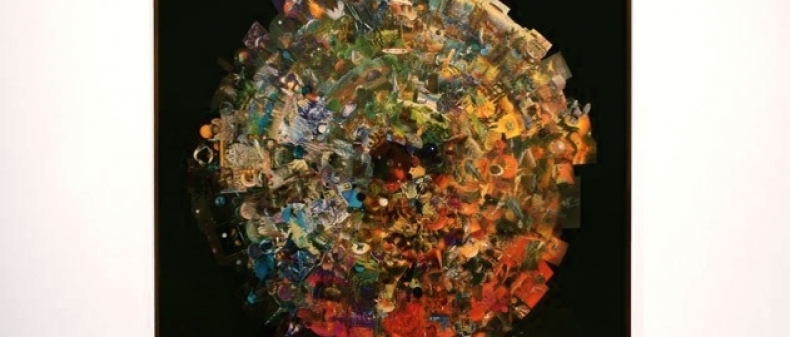
New Jerusalem (Jason de Haan, 2010)
Collage is a medium with borders so porous that it’s both impossible and irrelevant to bother defining. It was the weapon of choice amongst the Dadaists and the Cubists, who, I would argue, announced it as a medium unto itself. Moreover, as soon as it was recognized as such, it was also registered as an impulse, and applied freely and retrospectively as an interpretive tool to almost any art practice; during my undergrad, I read Arnold Hauser’s 1951 epic Social History of Art, and one of his principal arguments is that quotation in artwork is a collagist impulse and approach (he convincingly argues that the Sistine Chapel’s ceiling is a huge collage).
Hauser, in all his Modernist wisdom, is (of course) right. Collage is quotation, and also juxtaposition; the recycling and repurposing of pre-existing forms to both interrupt their old meaning and create new ones. It’s an anarchic intrusion on the semiotic order of things (which is why the Dadaists loved it so much), a scrambling of referents and references, and that impulse is one of the engines of art-making. So it should come as no surprise that, in the Oakville Galleries’ collage-based summer show Freedom of Assembly, strict collage (i.e. two-dimensional cut-out paper glued all together) is a tiny fragment of the media represented; the two locations are replete with photography, sculpture, video, painting and textile work.
The show is, in some sense, an overview of contemporary collage practices (through a Canadian lens), and the most interesting part of Freedom of Assembly is the picture of collage it presents. For instance, how broad it can be. The furthest (successful) curatorial reach is the inclusion of a monumental bric-a-brac sculpture by Valérie Blass and Sarah Cale’s paint collages, in which Cale manually transposes dried acrylic brushstrokes onto a canvas. Moreover, there are two major unintended trends in this show. The first is a kind of extreme precision: judging by Freedom of Assembly, contemporary collagists are surgical.
Sometimes, this precision is a necessary strength. Aleesa Cohene, for instance, takes movies (any and all, from Hollywood productions to self-help tapes) made during the span of her adolescence, and rearranges bits and clips to form entirely new narratives. Supposed To (2006) interrogates the idea of work, how our business (and busy-ness) defines us, and shows a woman (enacted by a slew of ‘80s actresses) going about her day. Cohene is exacting, but it’s all in the service of obfuscating her pieces’ construction. There is a staggering amount of editing involved in her videos, but the conceptual flesh and meat of her work gracefully obscures the arduousness of its skeletal structures.
Likewise, Jacob Whibley’s constructions of mundane ephemera (ticket stubs, file folders, etc) need that kind of tight exactitude. They are homages to Russian Constructivism, and without that mathematical attention to smooth curve, tight angle and crisp edge, the charm of both his illusion and allusion would seem shabby and amateurish. Instead, the meticulousness gives rise to an orderly poise, like watching a choreography of Platonic forms.
There are other instances in which this kind of care tumbles into fussy fastidiousness. Jennifer Murphy’s Pink Moon, a swirling collage of witchy creatures and objects (crystals, cats, spiders, frogs) seems mumsy, distinctly lacking the sense of mortal threat that the didactic material promises. And Elizabeth Zvonar’s History of Art, in which she jumbles illustrations of Janson’s canonical art history tome, seems — in all its care to keep the forms of the original illustrations intact — particularly empty and toothless.
Concomitant to this precision is an almost universal fealty to the source image. Almost no artists in this show in any way interrupt or interfere with the integrity of their source imagery. Balint Zsako’s installation at the Gairloch space, Monolith, exercises this fealty to a successful end: a series of anatomical drawings of skeletons are layered atop each other in a wall-sized arrangement, and the result is visually staggering: in their reiteration, the skeletons abstract themselves, creating an intricate wallpaper, like a morbidly anatomical William Morris design.
The best works in the show are the transgressors, the ones that pay no heed to neatness, that view their source material as a jumping off point rather than an immutable image. Firstly, Jason de Haan’s New Jerusalem diptych — two heaving planetoids made from science fiction book covers, twin meditations on apocalypse and transcendence — that was recently shown (and reviewed by me) at the Clint Roenisch gallery. In terms of Freedom of Assembly, it’s an announcement of the ambitious heights to which strict collage can scale. And Luane Martineau’s three works— Hanger, a hanging felt monster; Saskatchewan, a collection of woven paper and braided embroidery thread; and the peek-a-boo pornographic woven-paper Rider — further illustrate the kind of intense beauty and power that comes from the craft and precision serving the work rather than ruling it.
Freedom of Assembly continues at the Oakville Galleries until September 1.
______
Sholem Krishtalka is the Toronto Standard’s art critic.
For more, follow us on Twitter at @torontostandard, and subscribe to our newsletter.











